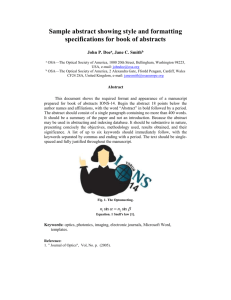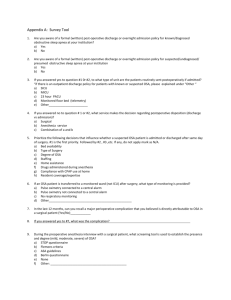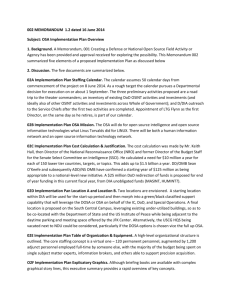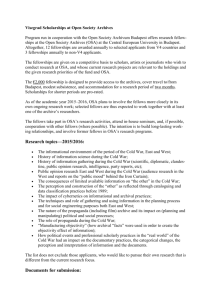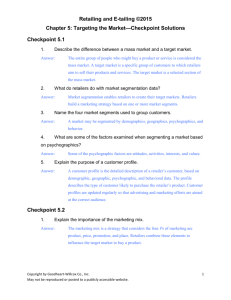event slides (Professor David Grant)
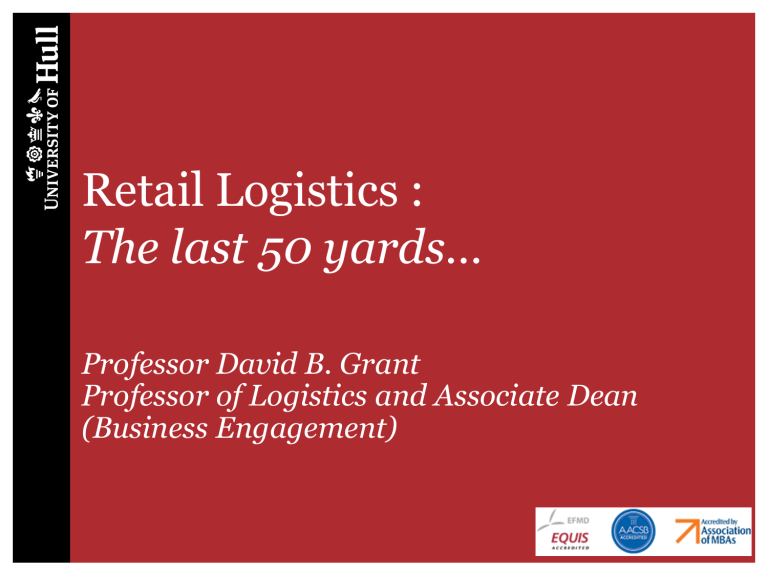
Retail Logistics :
The last 50 yards…
Professor David B. Grant
Professor of Logistics and Associate Dean
(Business Engagement)
Agenda
•
The context:
– the UK as the world’s leader in replenishment...?
– the importance of on-shelf availability/out-ofstocks in retail...
•
The ‘reality’ as found in academic research…
•
Is there a ‘strategic disconnect’ in retail logistics processes…?
•
Areas of future research...
•
Some provocative final thoughts...
The UK leads the way in retail replenishment...!
•
Fernie and Sparks claimed in 2004 that the UK had one of the most efficient grocery supply chains in the world.
Aastrup, Kotzab, Grant, Teller and Bjerre, International
Journal of Retail & Distribution Management (2008)
Oh Yeah...?
• UK grocery retailers have streamlined their supply chains in order to improve operational efficiencies. This process has been helped by ECR UK being integrated with, and supported by the UK’s IGD, formerly the Institute of Grocery Distribution and the fact that the
UK and GB are island entities with little or no competition nearby, thus encouraging the growth of oligopolistic retail chains. And yet, even the UK’s use of ECR is not without its flaws regarding collaboration and relationships between suppliers and retailers.
Grant, Supply Chain Forum: An International Journal (2005)
Are on-shelf availability (OSA) and out-of-stocks (OOS) still issues...?
Tesco’s CEO Philip Clarke’s “diagnosis of their Christmas 2011
‘under-performance’ was detailed: not enough staff, queues too long and too many under-stocked shelves. These problems, in theory, are easy for a retailer as rich as Tesco to fix: throw money at the problem. That is the plan, with more
– and better trained – staff to be recruited. The cost, though, will frighten shareholders who hadn't considered the Tesco profit machine might become unpredictable.”
Nils Pratley, The Guardian (2012)
“Stock availability is, of course, near the top of any consumer wish list, and that is as true in-store as it is online with stockouts leading to abandoned baskets and irritation in both channels. It’s also been a priority for most retailers for years, with varied degrees of success.”
Penelope Ody, Supply Chain Standard (2012)
Research/knowledge gaps concerning OSA/OOS...
•
The retail supply chain process (truly end-to-end?)
• Measurement of OSA and OOS (Glyn Carter’s presentation)
•
Changes in the UK food retail sector (a change in power)
•
Size of retailer (multiple v small independent operator)
• Products of importance to retailers
•
Products of importance to customers
•
Location of products in the supply chain (centralization v decentralization)
Grant and Fernie, European Retail Research (2009)
•
Recently, the Internet as a fulfilment channel that displaces instore availability
Penelope Ody, Supply Chain Standard (2013)
Main ‘actors’ affecting retail and in-store logistics
Senior
Management
Logisticians
Marketers Consumers
The impact of stock outs:
What do consumers really do…?
6%+37%+22% = 65% of consumers don’t patronise the retailer!!
19%+6%+22% = 47% of consumers don’t purchase the manufacturer’s product!!
IGD Consumer Research (2003)
Decrease in OSA from RDC to store…
A need to overhaul in-store logistics...?
Loss of grocery sales in Europe: €4 billion per annum...!
ECR Europe (2003)
Overall causes of OOS…?
• Promotional activities*
• Rate of sales
• Inaccurate inventory records
• Shrinkage
• Backroom
• Range density*
• Staff motivation
• Merchandising and shelf-filling*
• Planograms*
• New product introduction (NPI)*
• Packaging
*Causes related to marketing...?
Grant and Fernie, European Retail Research (2009)
The largest area for improvement…
• The ‘last 50 yards’ account for 50% of a retailer’s logistics costs…!
• Average grocery retailer’s store staff in
Germany spend 43% of their time on replenishment
• However, the best-practice German retailers only spend 22% of their time and have a 61% lower stock out rate…!
Thonemann, Behrenbeck, Kuepper and Magnus, Supply Chain Excellence
im Handel: Trends, Erfolgsfaktoren und Best-Practice-Beispiele (2005)
Research e.g. 1: Contextual differences
• Case study of how OSA initiatives from a major grocery retailer’s HQ were implemented at distribution centre (DC) and store level in
Scotland
•
Assessed the impact on OSA of:
– online shopping
– promotions
– the nature of convenience stores
Fernie and Grant, International Journal of Logistics Management (2008)
Case study findings…
•
OSA was similar between internet shopping store and other comparable Scottish stores (96% v 97%); Internet store had several measures to enhance availability: a back stockroom extension and dedicated picking space and daily and weekly reports from personal shoppers to stock control managers instore
•
OSA was better for promotional items compared to nonpromotional items (98% v 96%); increased shelf space allocation and closer monitoring of promotions in-store improved OSA
•
OSA at convenience stores was much lower than the supermarkets (90% v 97%) and lower than overall UK convenience stores (94%); Scottish stores receive deliveries from the same depots as supermarkets, unlike some of their
English counterparts, which means convenience stores are less likely to receive scarce stock from the DC as larger stores get priority
Research e.g. 2: OSA and profitability
•
Primary research with a major UK grocery retailer and one of its suppliers in the chilled juice category; part of ECR UK Availability Subgroup activities
•
Data collected from internal records of both parties and also from electronic point of sale (EPOS) scanner data and analysed by ourselves and dunnhumby
•
Developed a matrix to assist retailers and suppliers in determining and managing optimal levels of OSA with regards to profitability
Trautrims, Grant, Fernie and Harrison, Journal of Business Logistics (2009)
High profit but low availability…
Target
Quadrant
Research e.g. 3: Non-grocery OSA
•
Exploratory research carried out with national ‘high street’ retailers
•
Sectors investigated (slow and fast fashion excluded):
- Mobile phones
- Bookstores
- General merchandiser
- Electronics
•
Interview topics included availability, forecasting, delivery and improvements to OSA / OOS situations
Grant and Fernie, International Journal of Retail & Distribution Management
(2008)
Conclusions about non-grocery retailers...
•
They are not as focused on OSA as grocery retailers
•
Major constraints affecting OSA performance are poor supplier performance, lack of system data accuracy, lack of stock investment, and poor in-store replenishment processes
•
Little collaboration is taking place to improve OSA performance; few/limited joint initiatives participation
•
General merchandiser appeared to be ahead of the other three retailers and may have benefited from
adopting techniques and practices used by other large retailers in the grocery sector, however it went out of business in late 2008…!
General conclusions about current retail logistics…
•
The ‘last 50 yards’ appear as a recurrent theme in all examples – in-store replenishment
•
Logistics and supply chain activities have become very sophisticated and replenishment is much improved from manufacturer/supplier to RDC and retail back-of-store
•
However, there seems to be a general breakdown from that point forward as in-store replenishment appears chaotic and unfocussed
•
Thus, is there a ‘strategic disconnect’ between senior management, retail logistics and SCM activities, in-store marketing and merchandising and consumers…?
A strategic disconnect…?
Requirement planning and purchasing
Inbound logistics
Supplier
Chaotic, in-store replenishment …
Information flow
Order handling , Demand forecasting and Production
Warehousing, marketing, sales and distribution
Consumer
Supplier
Raw- materials
Finished goods
Consumer
Supplier Consumer
Materials flow
Lean, efficient supply chain distribution to fulfil the back of store
(including reverse logistics)…
Areas for future research...
•
How well do senior management, store management, marketing and logistics/SCM functions communicate?
– What should the strategic goals be?
– How do their KPIs interact or are they in conflict?
– Who controls overall OSA/OOS, inventory costs, write-downs, etc.?
•
Is a retail store nothing more than a warehouse where consumers come to pick ,pack and transport inventory to their in-house storage?
– Do we need hedonic shopping in an era of commodity purchases such as groceries in a
‘time-poor’ and ‘cash-rich’ economy?
– Does retailing really only reflect point-of-origin to point-of-consumption in logistics /
SCM definitions?
– Should we treat retail stores like a warehouse and design their systems accordingly, thus turning consumers into logisticians?
–
What are the effects of Internet ‘displacement’ and interactions?
–
What about the inability to deliver over 30% of online orders and associated costs
(Logistics Manager, 2013) and mechanisms for unattended delivery
•
What about human resources in-store?
–
How do you motivate staff on £6.13 an hour to check for gaps and fill them?
–
Should stores have different types of personnel akin to warehouse staff?
–
What about using technology like ‘voice picking’ to provide ‘voice replenishment’?
Some provocative final thoughts...
•
Why not ban all fossil fuel traffic in major
urban areas and depend only on public
transportation like other countries in Europe?
What should the level, intensity and ability be of such public transport; who should pay for it?
•
Why not build more motorways across the country to reduce congestion? E.g. Scotland central belt v metropolitan Toronto; similar population but 12 lanes of Highway 401 in Canada v A8/M8 fiasco in
Scotland. What do we do about NIMBYs and the
costs?
•
Why not reduce number of SKUs and variety to
reduce logistical / merchandising issues and
consumer confusion / decision-making?
Thank you; any questions or comments...?
For further information: d.grant@hull.ac.uk
